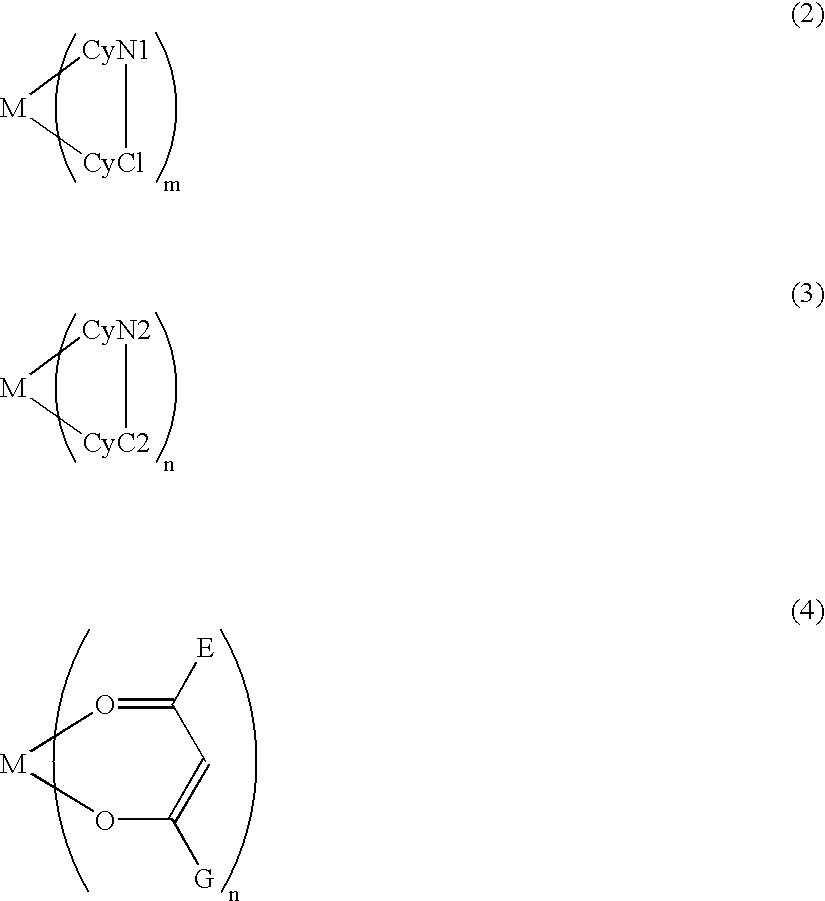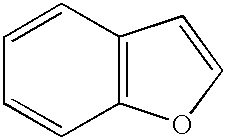Metal coordination compound, luminescence device and display apparatus
a technology of luminescence device and coordination compound, which is applied in the direction of discharge tube luminescnet screen, other domestic articles, natural mineral layered products, etc., can solve the problems of material change or life deterioration, high probability of deactivation process, and limited luminescence efficiency to at most 25%
- Summary
- Abstract
- Description
- Claims
- Application Information
AI Technical Summary
Problems solved by technology
Method used
Image
Examples
examples 2-10
[0117] Each of luminescence devices having a layer structure shown in FIG. 1B were prepared in the following manner.
[0118] On a 1.1 mm-thick glass substrate (transparent substrate 15), a 100 nm-thick film (transparent electrode 14) of ITO (indium tin oxide) was formed by sputtering, followed by patterning to form a stripe electrode including 100 lines each having a width of 100 nm and a spacing with an adjacent line of 10 nm (i.e., electrode pitch of 110 nm).
[0119] On the ITO-formed substrate, three organic layers and two metal electrode layers shown below were successively formed by vacuum (vapor) deposition using resistance heating in a vacuum chamber (10.sup.-4 Pa).
[0120] Organic layer 1 (hole transport layer 13) (40 nm): .alpha.-NPD
[0121] Organic layer 2 (luminescence layer 12) (30 nm): co-deposited film of CBP:metal complex (metal coordination compound shown in Table 18) (95:5 by weight)
[0122] Organic layer 3 (electron transport layer 16) (30 nm): Alq3
[0123] Metal electrode lay...
example 11
[0132] A color organic EL display apparatus shown in FIG. 2 was prepared in the following manner.
[0133] An active matrix substrate had a planar structure basically similar to a structure described in U.S. Pat. No. 6,114,715.
[0134] Specifically, on a 1.1 mm-thick glass substrate, top gate-type TFTs of polycrystalline silicon were formed in an ordinary manner and thereon, a flattening film was formed with contact holes for electrical connection with a pixel electrode (anode) at respective source regions, thus preparing an active matrix substrate with a TFT circuit.
[0135] On the active matrix substrate, a 700 nm-thick pixel electrode (anode) of ITO having a large work function was formed in a prescribed pattern. On the ITO electrode, prescribed organic layers and a 100 nm-thick Al electrode (cathode) were successively formed by vacuum deposition with a hard mask, followed by patterning to form a matrix of color pixels (128.times.128 pixels).
[0136] The respective organic layers correspo...
example 12
Synthesis of Ex. Comp. No. 31
[0141] It is easy to synthesize the following compound in the same manner as in Example 1 except for using 2-bromopyridine (made by Tokyo Kasei Kogyo K.K.) instead of 2-chloro-5-trifluoromethylpyridine in Example 1.
[0142] Tris[2-(benzofuran-2-yl)pyridine-C.sup.3,N]iridium (III).
PUM
| Property | Measurement | Unit |
|---|---|---|
| excitation wavelength | aaaaa | aaaaa |
| excitation wavelength | aaaaa | aaaaa |
| width | aaaaa | aaaaa |
Abstract
Description
Claims
Application Information
 Login to View More
Login to View More - R&D
- Intellectual Property
- Life Sciences
- Materials
- Tech Scout
- Unparalleled Data Quality
- Higher Quality Content
- 60% Fewer Hallucinations
Browse by: Latest US Patents, China's latest patents, Technical Efficacy Thesaurus, Application Domain, Technology Topic, Popular Technical Reports.
© 2025 PatSnap. All rights reserved.Legal|Privacy policy|Modern Slavery Act Transparency Statement|Sitemap|About US| Contact US: help@patsnap.com



